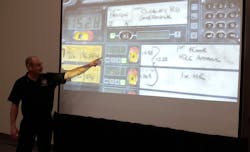FHWorld16: Fireground Air Management - A US/UK Perspective
Source Firehouse
SAN DIEGO, Calif. – Fires burn the same in the United States as they do in United Kingdom and, for the most part, firefighters in both countries fight them the same way, with one notable exception – how breathing air is managed.
David Payton, the lead breathing apparatus instructor for the West Midlands Fire Service Academy in Birmingham, UK, lead a class at Firehouse World titled; “Fireground Air Management – US/UK Perspective.”
In the class, he explained how firefighters in the United Kingdom have used a system focused on an Entry Control Point (ECP) and how it works to help with air management, accountability and technology using telemetry.
Telemetry, Payton explained, is a wireless electronic system that broadcasts firefighters’ air supply and use back to command. It also provides a real-time method of alerting firefighters to evacuate and a way for firefighters to alert those on the outside they’re in trouble or are evacuating because of something they’ve encountered.
“It’s really the only way to fight fire that I know works effectively,” Payton said.
Payton was one of several instructors Firehouse invited to speak from abroad at Firehouse World, giving the conference an international focus.
Telemetry and entry control works fantastic,” said Payton, who is an officer with 26 years of experience working in a 1,300-member department protecting a population of 3.8 million in an area of 250 square miles. “We have refined it over many, many evolutions. …We’ve been using it for about five or six years.”
Like firefighters in the United States, firefighters are steeped in tradition and subscribed to the “it’s tried and true” formula for fire techniques, Payton said. For illustration, Payton said UK firefighters are required to carry a “bobbin of string” as a way of retracing their steps to exit structures. It’s an arcane method of firefighter location, but it’s another one of those time-tested traditions that has lingered.
Payton thinks it’s not just old fashioned, it’s dangerous as the approximately quarter inch string, zig-zags through a structure.
Payton is fighting to have that rule stricken from the standards, but it’s proving a bit of challenge.
He’s fighting just as hard to promote telemetry.
Payton said the SCBA vendor used by his department provides what could be considered an electronic accountability board. Each breathing apparatus, or BA, as UK firefighters call the United States SCBA equivalent, has a yellow tag on it with a microchip built in which correlates to the BA to which it was attached.
As firefighters don the BAs, an entry control point (ECP) officer pulls the tag, records the “tally” of air in the cylinder on the tag and plugs it into the electronic board which receives a signal from the deployed BA indicating the amount of air remaining in the cylinder and its rate of consumption. It tallies the air and indicates to the ECP officer when the firefighters should be exiting.
It also allows incident command to alert firefighters when they should evacuate the fire building for optimal safety.
Using a video to help illustrate its operations, Payton played a scenario which showed the operator could, with a single button, alert everyone inside to evacuate the building.
It will also show when individual firefighter should be exiting the building, or are in trouble and need help to get out of the fire building.
It’s a system that has kept UK firefighters safe for years, Payton said, adding that the last firefighter death on the scene was in 2009 when he got separated from his partner because of miscommunication. Those on the outside the fire building knew exactly where he was, but could not reach him in time for a rescue.
Some have baulked at the use of telemetry as it is another mechanical item and it seems like it would take a long time to deploy.
“It’s not laborious at all,” said Payton, noting that a good ECP can get the board up and running in less time than it would take firefighters to put on the BA.
“If there’s smoke coming from the building, they know they’re going inside,” Payton said. So in the time it takes to do an initial size up and 360-degree walk around of the building, each person would have a BA on, he said.
“I would give them a briefing, take their tag and send them on their ways,” Payton said.
No one in attendance at the class on Monday said they used telemetry which prompted Payton to ask why.
“Would it work for your department or would you really have to sell it,” Payton asked. “It’s really not laborious.”
He recommended the US firefighters take a close look at the technology and incorporate it in their departments.
“It works and it really is the only way I know how to fight fires now,” he said.






